Devonshire splits, often simply called “splits,” are a delightful variety of sweet buns hailing from Devon, a picturesque county in England. These soft, yeasted buns are distinguished by their light and airy texture, making them an essential component of the traditional British cream tea. Unlike their sturdier cousin, the scone, Devonshire splits are typically more delicate and are best enjoyed fresh out of the oven.
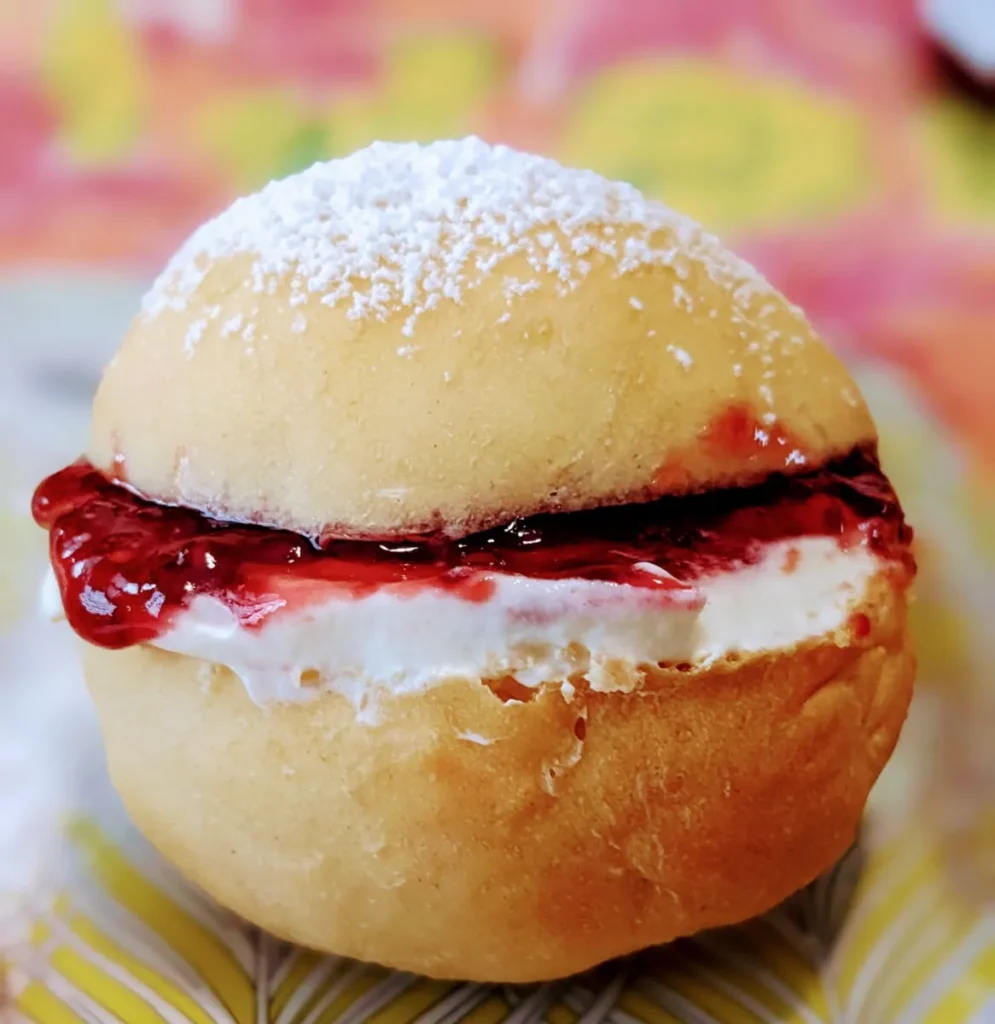
The process of making these buns involves a simple but precise mix of flour, sugar, butter, milk, and yeast. The dough is allowed to rise, creating the soft, fluffy texture that splits are known for. Once baked, they present a lightly golden exterior with a tender, slightly sweet crumb.
To serve, the splits are sliced horizontally but not all the way through, creating a pocket that’s perfect for filling. They are traditionally slathered with clotted cream and a dollop of jam—strawberry or raspberry being popular choices. This combination of the warm, buttery bun with the rich cream and sweet, tangy jam provides a taste experience that is both comforting and indulgent, embodying the essence of Devonshire’s culinary heritage.
Kitchen Tools Needed
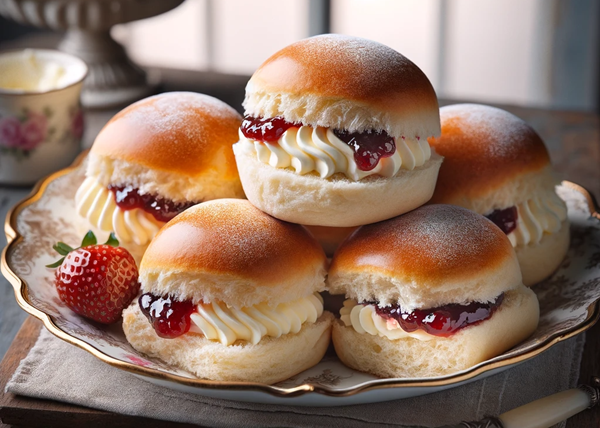
Ingredients for Devonshire Splits
How To Make Devonshire Splits?
Ingredients Preparation
Start by gathering all the ingredients. Ensure the butter is softened, which will make it easier to incorporate into the dough. Warm the milk slightly; it should be lukewarm, not hot, to effectively activate the yeast without killing it.
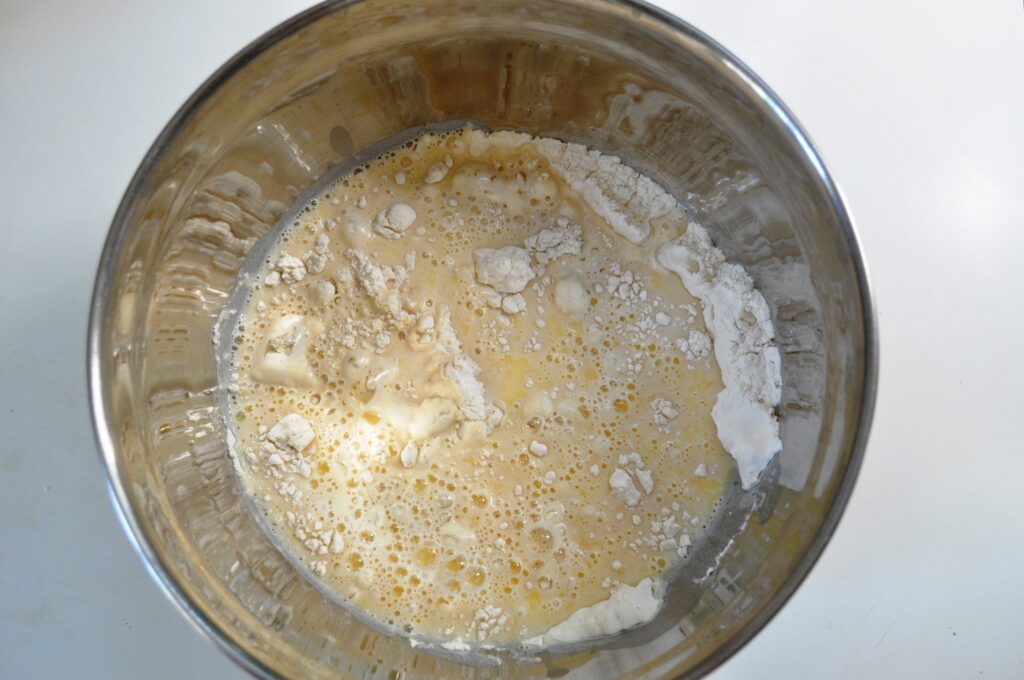
Mixing the Dough
In a large mixing bowl, combine the all-purpose flour, sugar, and salt. Mix these dry ingredients together until evenly distributed. In a separate small bowl, dissolve the instant yeast in the lukewarm milk, then pour this mixture into the flour blend. Add the softened butter to the bowl.
Kneading the Dough
Begin mixing the ingredients until a dough starts to form. Transfer the dough onto a lightly floured surface and knead for about 10 minutes or until the dough is smooth and elastic. This process is crucial as it develops the gluten in the flour, giving the splits their structure and soft texture.

First Rise
Place the kneaded dough in a greased bowl, turning once to coat the surface of the dough with a bit of oil or butter to prevent it from drying out. Cover the bowl with a clean cloth or plastic wrap and let the dough rise in a warm, draft-free area. Allow it to rise until it doubles in size, which typically takes about 1 to 1.5 hours depending on the room temperature.
Shaping the Splits
Once the dough has doubled, punch it down gently to release any air bubbles. Turn it out onto a lightly floured surface and divide it into equal pieces — usually 10 to 12 splits are ideal from this amount of dough. Shape each piece into a smooth ball and then flatten slightly to form the traditional split shape.

Second Rise
Arrange the shaped splits on a baking tray lined with parchment paper, leaving enough space between each for expansion. Cover them loosely with a greased plastic wrap or a light kitchen towel. Let them rise again in a warm place until nearly doubled in size, which should take about 30 to 45 minutes.
Baking
Preheat your oven to 220 degrees Celsius (428 degrees Fahrenheit). Gently brush the tops of the risen splits with beaten egg, ensuring you cover them gently to avoid deflating. This egg wash will help in achieving a golden and glossy crust once baked.
Bake in the preheated oven for about 10 to 15 minutes or until the splits are golden brown and sound hollow when tapped on the bottom.

Cooling and Serving
Remove the splits from the oven and transfer them to a wire rack to cool. They are best served slightly warm. Traditionally, Devonshire splits are sliced open and filled with jam and clotted cream, making them a delightful treat for tea time or a special occasion. Enjoy your homemade Devonshire splits with a cup of tea or as part of an afternoon cream tea spread.
What Goes Yummy With Devonshire Splits?
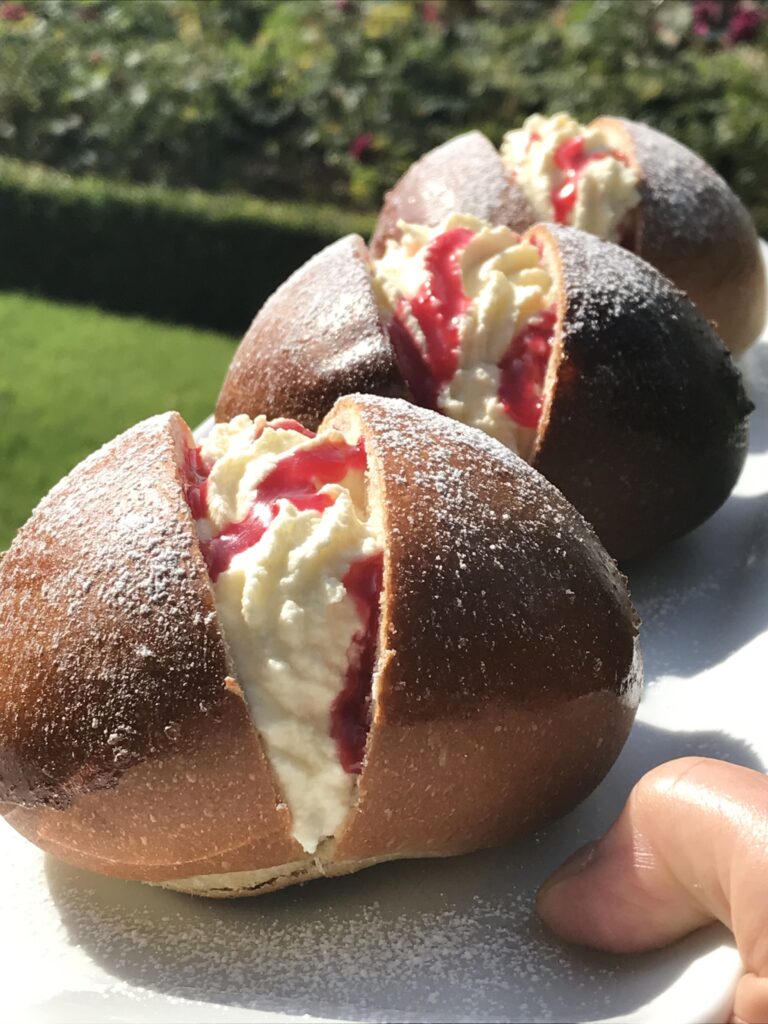
Health Benefits
Tips and Tricks

Variations
Substitutions
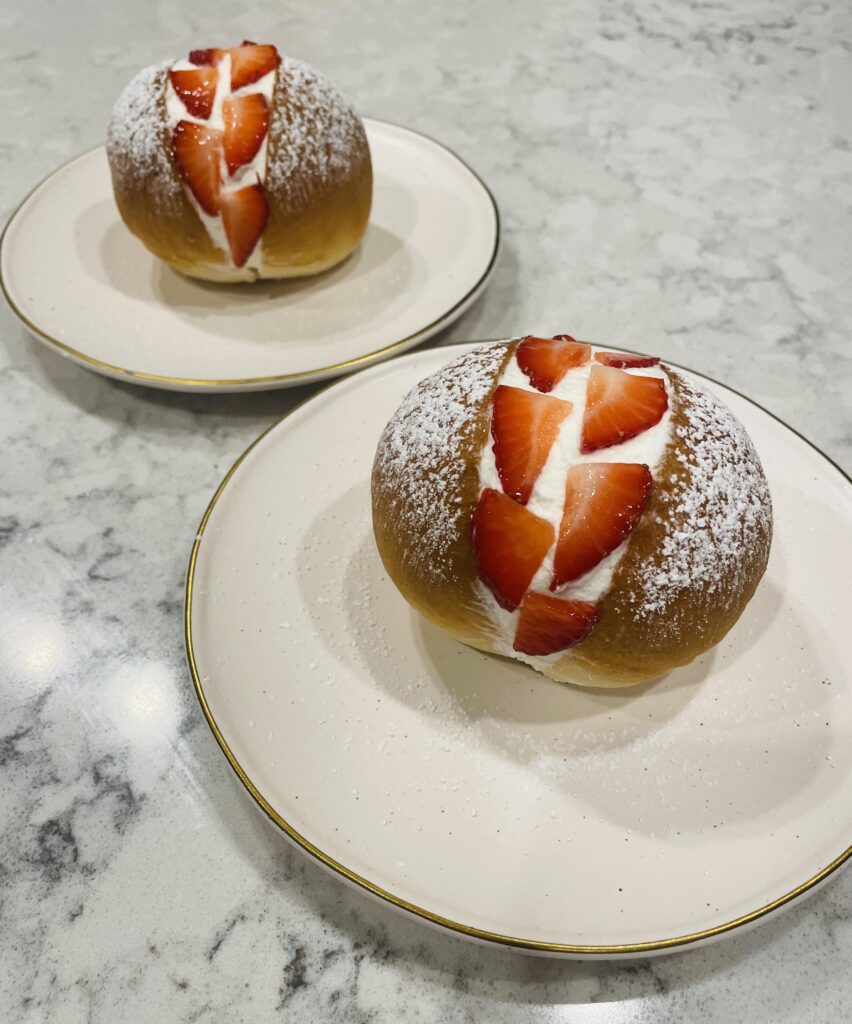
Making Ahead
Storage
Reheating
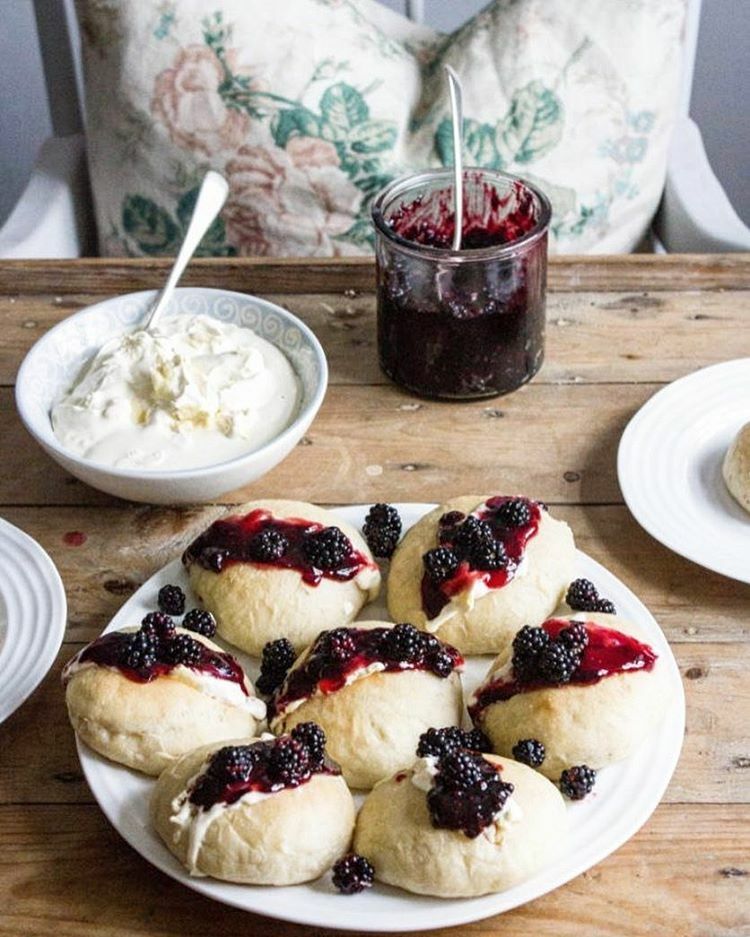
Nutritional Facts
Other nutrients:
Looking For Yummy Desserts? Must Try
Best Almond Flour Pumpkin Muffins Recipe
Easy Puff Pastry Mince Pies Recipe
Frequently Asked Questions – FAQ’s
Devonshire Splits
Course: DessertCuisine: BritishDifficulty: Easy4
servings1
hour30
minutes15
minutes200
kcalIngredients
250 grams (2 cups) All-purpose Flour – Forms the base of the dough.
25 grams (2 tablespoons) Sugar – Adds a slight sweetness to the buns.
5 grams (1 teaspoon) Salt – Enhances the flavor.
15 grams (1 tablespoon) Butter, softened – Adds richness and tender texture.
150 ml (2/3 cup) Whole Milk, lukewarm – For moisture and to activate the yeast.
7 grams (1 packet) Instant Yeast – Leavens the dough, making it rise.
1 Egg, beaten – Used for an egg wash to give the splits a golden crust.
Directions
- Start by gathering all the ingredients. Ensure the butter is softened, which will make it easier to incorporate into the dough. Warm the milk slightly; it should be lukewarm, not hot, to effectively activate the yeast without killing it.
- In a large mixing bowl, combine the all-purpose flour, sugar, and salt. Mix these dry ingredients together until evenly distributed. In a separate small bowl, dissolve the instant yeast in the lukewarm milk, then pour this mixture into the flour blend. Add the softened butter to the bowl.
- Begin mixing the ingredients until a dough starts to form. Transfer the dough onto a lightly floured surface and knead for about 10 minutes or until the dough is smooth and elastic. This process is crucial as it develops the gluten in the flour, giving the splits their structure and soft texture.
- Place the kneaded dough in a greased bowl, turning once to coat the surface of the dough with a bit of oil or butter to prevent it from drying out. Cover the bowl with a clean cloth or plastic wrap and let the dough rise in a warm, draft-free area. Allow it to rise until it doubles in size, which typically takes about 1 to 1.5 hours depending on the room temperature.
- Once the dough has doubled, punch it down gently to release any air bubbles. Turn it out onto a lightly floured surface and divide it into equal pieces — usually 10 to 12 splits are ideal from this amount of dough. Shape each piece into a smooth ball and then flatten slightly to form the traditional split shape.
- Arrange the shaped splits on a baking tray lined with parchment paper, leaving enough space between each for expansion. Cover them loosely with a greased plastic wrap or a light kitchen towel. Let them rise again in a warm place until nearly doubled in size, which should take about 30 to 45 minutes.
- Preheat your oven to 220 degrees Celsius (428 degrees Fahrenheit). Gently brush the tops of the risen splits with beaten egg, ensuring you cover them gently to avoid deflating. This egg wash will help in achieving a golden and glossy crust once baked.
- Bake in the preheated oven for about 10 to 15 minutes or until the splits are golden brown and sound hollow when tapped on the bottom.
- Remove the splits from the oven and transfer them to a wire rack to cool. They are best served slightly warm. Traditionally, Devonshire splits are sliced open and filled with jam and clotted cream, making them a delightful treat for tea time or a special occasion. Enjoy your homemade Devonshire splits with a cup of tea or as part of an afternoon cream tea spread.
Conclusion
Devonshire splits are a charming and delightful addition to any tea table. Known for their light, fluffy texture and slightly sweet taste, they serve as a versatile canvas for various fillings, ranging from traditional clotted cream and jam to more innovative choices like lemon curd or chocolate spread.
While they do require some patience in preparation, particularly during the kneading and rising phases, the result is a treat that perfectly balances simplicity and indulgence. Whether enjoyed in a classic British cream tea setting or as a part of a festive gathering, Devonshire splits promise to bring a touch of elegance and satisfaction to your culinary experience, making them a beloved choice for bakers and diners alike.







